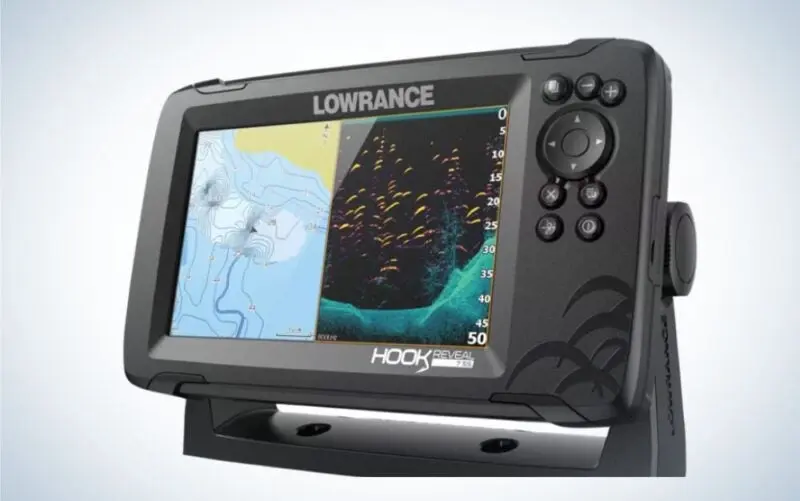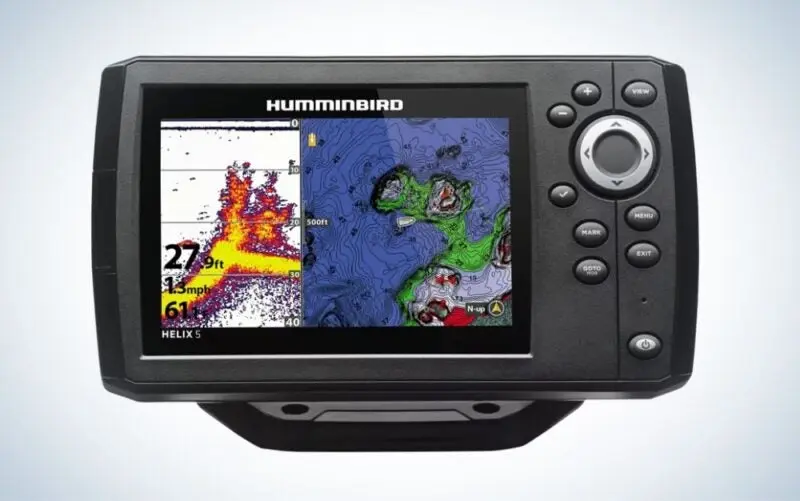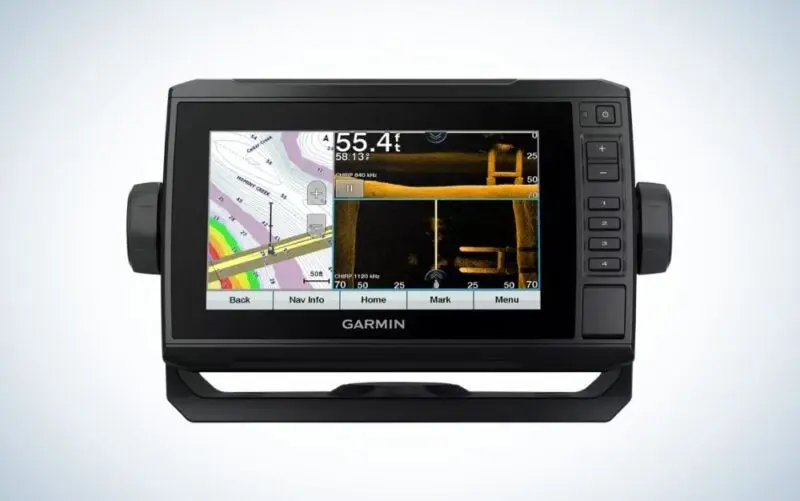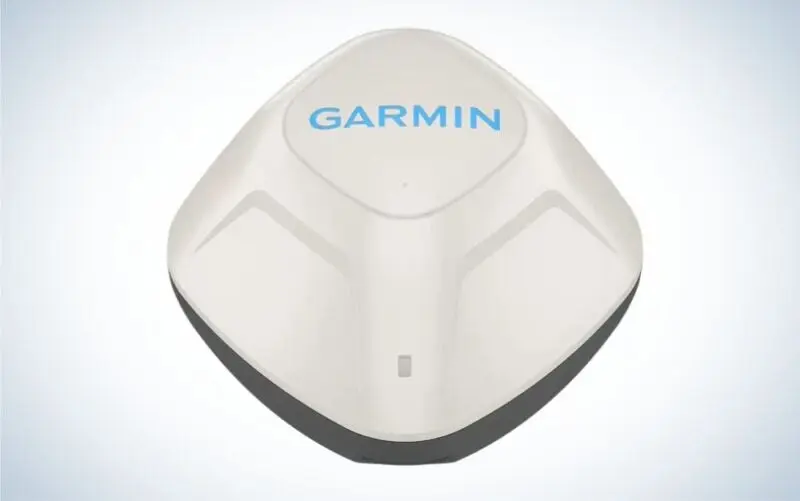_We may earn revenue from the products available on this page and participate in affiliate programs. Learn more ›
_
Best Overall

Lowrance Hook Reveal 7x Splitshot
LEARN MORE
Summary
The combination of down imaging and sonar creates some of the clearest images of what’s below.
Best for Kayaks

Humminbird HELIX 5 CHIRP GPS G3 Fish Finder/Chartplotter
LEARN MORE
Summary
The Helix 5 gives anglers down imaging, sonar, and navigation capabilities with a five-inch screen perfect for kayaks and smaller boats.
Best for Boats

Simrad Cruise 5-5-inch GPS Chartplotter
LEARN MORE
Summary
Simrad’s cruise feature helps you navigate new waters and still find fish.
allow anglers to navigate new water bodies, find hidden structures, and catch more fish. It’s easy to get carried away and spend thousands on giant screens and fancy features. For those on a budget, there are a variety of affordable fish finders available. These units are user-friendly, durable, and ready with some impressive and useful features. Here are some options for the best fish finders under $500.
Best Overall: Lowrance Hook Reveal 7x Splitshot
Best Features: Garmin ECHOMAP UHD 73sv Fish Finder/Chartplotter Combo
Best for Kayaks: Humminbird HELIX 5 CHIRP GPS G3 Fish Finder/Chartplotter
Best Portable: Garmin STRIKER Cast Castable Sonar
Best for Boats: Simrad Cruise 5-5-inch GPS Chartplotter
How We Picked The Best Fish Finders Under $500
In my free time, I find myself exploring South Florida’s shallow water flats in search of tarpon and snook. Navigating shallow water is tricky without good electronics and I’ve come to depend on my fish finders. After experimenting with different fish finders, I’ve learned they need to be reliable and accurate. I prefer models with plenty of imaging features to find fish and accurate maps to know where I can run my boat. These are the criteria I used to find the best fish finders under $500:
Screen Size: How big is the screen and is it easy to see?
Modes: What imaging modes are available?
Touch Screen: Is the unit a touch screen or joystick?
Ease of Use: How user-friendly is the unit for new anglers?
Trolling Motor Compatibility: What trolling motors
are the unit compatible with?
Durability: How does the unit hold up in rough water or rain?
The Best Fish Finders Under $500: Reviews & Recommendations
Best Overall: Lowrance Hook Reveal 7x Splitshot
Best Overall

Lowrance Hook Reveal 7x Splitshot Bass Pro Shop
Specs
Screen Size: 7-inch display
Imaging Modes: Down scan and Sonar
Compatibility: MotorGuide or Minn Kota
Pros
Easy to setup
FishReveal technology combines sonar and DownScan imaging
Sturdy mounting hardware
Cons
Not a touch screen
have a reputation for innovative technologies and the Hook Reveal is no exception. This budget-friendly model comes preloaded with 4,000 lake maps with one-foot contours. For those fishing new water bodies, studying drop-offs and ledges can narrow down likely spots. If you prefer more detail, you can utilize GenesisLive to create real-time maps pinpointing the smallest holes. To locate structure, Lowrance developed a unique combination of down scan and sonar imaging. The down scan reads structure like submerged timber or rock piles while the sonar marks fish. Together this gives anglers realistic images to pinpoint where fish are holding.
Best Features: Garmin ECHOMAP UHD 73sv Fish Finder/Chartplotter Combo
Best Features

Specs
Screen Size: 7 inches
Imaging Modes: Down scan and side scan
Compatibility: MotorGuide or Minn Kota
Pros
Side scan and down scan
Easy to use touch screen
NMEA compatible
Cons
Look for sale prices
One of the budget-friendly Garmin fish finders
, the Garmin ECHOMAP UHD 73sv is designed for fishermen wanting the most out of their units. It comes ready with side imaging, down imaging, and sonar in a single transducer. Side imaging offers crisp images of structures like bridge pilings, timber, and weed edges. My go-to tactic when fishing new waters is to cruise around points with side imaging until I find a structure that holds fish. When dialed in correctly, it will even pick up bigger fish like musky or tarpon. It comes preloaded with 17,000 lake maps to navigate new water bodies of water and avoid shallow areas. Add in an NMEA 2000 system and anglers can read engine data on the unit while heading to their spots. At a budget-friendly price, the ECHOMAP offers features typically only found in flagship models.
Best for Kayaks: Humminbird HELIX 5 CHIRP GPS G3 Fish Finder/Chartplotter
Best Kayak

Specs
Screen Size: 5 inches
Imaging Modes: 2D Sonar
Compatibility: Minn Kota
Pros
User-friendly
Down imaging provides realistic images of the bottom structure
The waypoint button lets you instantly drop pins on spots
Cons
Not touch screen
It’s no secret that Humminbird fish finders
—specifically the Humminbird Helix series—are durable and user-friendly. For kayak anglers, the Helix 5 is a perfect fit. Its five-inch screen is easy to read without taking up too much space on a kayak. Anglers can use sonar to mark fish and use down imaging to find structure. While not a touch screen, the oversized keypad makes it easy to navigate between screens. You can even preset views to see GPS maps and imaging side by side. The unit is covered in durable plastic housing. Even in the harshest conditions, the unit keeps water out and performs flawlessly. The options packed into this five-inch setup make it a budget fish finder for kayak
anglers wanting to improve their fishing.
Best Portable: Garmin STRIKER Castable Sonar
Best Portable

Specs
Screen Size: Pairs with phone
Imaging Modes: Sonar and ice fishing modes
Compatibility: All smartphones
Pros
Easy-to-use app
Castable for scanning structure off the bank
Works up to 200 feet away
Cons
Best for land-based anglers
Understanding bottom structure and drop-offs are crucial to catching fish. Previously, bank anglers were at a disadvantage when it came to finding these structures. Like other portable fish finders
, the Garmin Striker allows anglers to cast out the transducer and get live imaging to their phone. A well-designed app reads just like a fish finder screen while giving anglers the ability to stay mobile. For those fishing hard water, the Striker doubles as a flasher. Drop it in an ice hole and your phone will give you live imaging of what’s going on below. As a land-based angler, I find myself carrying a Striker in my tackle bag when I know I’ll be fishing new water.
Best for Boats: Simrad Cruise 5-5-inch GPS Chartplotter
Best for Boats

Specs
Screen Size: 5-inch screen
Imaging Modes: Sonar
Compatibility: MotorGuide
Pros
Perfect for recreational boaters
The easy dial system allows you to navigate between screens
Preloaded with US coastal maps for saltwater boating
Cons
Only comes with sonar for fish finding
In the boating and yachting world, there are few brands as well-known as Simrad. Its Cruise series is perfect for pleasure boaters taking an occasional fishing trip. The interface is designed around boating. It gives live engine data, battery levels, and locations. Whether you’re new to boating or experienced, live data helps you run at an optimal speed and minimize mechanical issues. For saltwater boating, it comes preloaded with US coastal maps. This marks channels and shallow water flats to stay on course and not run aground. Paired with traditional sonar, you can see bottom contours and fish if you want to take a few casts. The interface is easy-to-use and is sized right for smaller boats.
What to Consider When Choosing a Fish Finder
A fish finder can make or break your day on the water. Between different brands and technologies, there are plenty of options available. Knowing which ones suit your needs will optimize performance and save you money on unnecessary features. Fish finders should have easy-to-use imaging, solid mounting hardware, and trolling motor compatibility. Units that check these boxes cut down the learning curve on new water bodies and put you on fish.
Features
Finding a unit that is user-friendly with a variety of scanning options is a must. To start, any fish finder on my boat must have satellite maps. This is crucial to find your way around new water bodies or keep you from getting lost when there’s no service. Features like sonar, down imaging, and side imaging work great for locating fish. The combination of these three allows anglers to see what is around the boat and under it.
Mounting Hardware
Look for units with metal mounting brackets when possible. Other good options are swivel mounts that allow you to manipulate the screen. Bass anglers have even gone as far as developing special mounting plates to keep all their screens secure in rough water. Whatever you go with, make sure it can withstand the conditions you plan on using it in.
Trolling Motor Compatibility
Fish finders that are compatible with your trolling motor can unlock useful features. With spot lock compatible motors, you can drop a pin or draw a track and your trolling motor will follow it. When I find a school of fish or a particular piece of structure, spot lock keeps me dialed in. Not all trolling motors are compatible with all fish finders, so be sure the one you choose will work for your motor.
FAQs
Q: What is the simplest fish finder?
The easiest fish finders to use are sonar units. These fish finders only scan the bottom and ping back fish below. Without any other features, these units are ready to go out of the box. For anglers, this is an easy way to see depths, bottom structure, and fish. Target the drop-offs and fish will be hiding just off ledges waiting to ambush prey.
Q: Do all fish finders have GPS?
Not all fish finders have GPS. While most models available will have some sort of navigation features there are basic options available. The basic units come with sonar to mark fish and structure. They are easy to use and cheap compared to other models. Anglers just starting or fishing smaller water bodies can familiarize themselves with fish finders for a minimal investment.
Q: Is a fish finder and a depth finder the same thing?
Modern fish finders and depth finders are not the same things. They both work by sending a signal downwards that reflects back. When a fish is in the signals path it shows up as a U-shaped mark on a fish finder. Depth finders use this same process but instead read the time it takes for the signal to return. These are great for offshore fishing and can find deep canyons or drop-offs where pelagic fish may hold.
Q: How deep can a fish finder go?
It depends on the model of the fish finder and transducer but some can read as deep as 400 feet. In that range depth finders mark fish best in 200 feet of water or less. For anglers wanting to see deeper, a depth finder can be used. Depth finders can read thousands of feet deep. Unfortunately, they do not mark fish but can help anglers locate likely spots where fish should hold.
Q: How long do fish finders last on average?
The lifespan of your fish finder will depend a lot on how well you maintain and take care of it. If maintained properly, a good fish finder should last between four and six years. At that point, you should consider replacing your fish finder so you can take advantage of new technology and updates.
Best Fish Finders Under $500: Final Thoughts
Best Overall: Lowrance Hook Reveal 7x Splitshot
Best Features: Garmin ECHOMAP UHD 73sv Fish Finder/Chartplotter Combo
Best for Kayaks: Humminbird HELIX 5 CHIRP GPS G3 Fish Finder/Chartplotter
Best Portable: Garmin STRIKER Cast Castable Sonar
Best for Boats: Simrad Cruise 5-5-inch GPS Chartplotter
Fish finders are great tools for anglers on the water. When dialed in properly, they can give you an edge over other anglers. Look for units with features you want, that are easy to use, and durable. While fish finders will help cut down the learning curve there is no substitute for time on the water. Choose something that fits your boat and your style of fishing and spend some time using it.
Why Trust Us
For more than 125 years, Field & Stream has been providing readers with honest and authentic coverage of outdoor gear. Our writers and editors eat, sleep, and breathe the outdoors, and that passion comes through in our product reviews. You can count on F&S to keep you up to date on the best new gear. And when we write about a product—whether it’s a bass lure or a backpack—we cover the good and the bad, so you know exactly what to expect before you decide to make a purchase.






